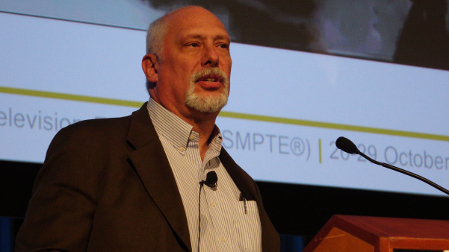SMPTE 2015: HDR, HFR and Color for 4K and Beyond
HOLLYWOOD—Capturing video in the age of more “K’s” is not just a matter of more, faster and a bigger box of crayons. Higher frame rates, high dynamic range and wider color gamut for 4K and beyond come with complications interelated with other aspects of production. Jim DeFilippis, Klaus Weber and Hiroaki Iwasaki tackled the various aspects of these visual enhancements at the SMPTE Technical Conference on Tuesday.

Jim DeFilippis
“The higher one goes up in frame rate, the less the exposure time, but with a longer exposure time, it will be more blurry,” said Jim DeFilippis, broadcast consultant and program manager for SMPTE. “Shorter exposure time is less motion blur and more judder and strobing.”
DeFilippis and Drs. Corey Carbonara and Michael Korpi of Baylor set about to find the sweet spot for frame rates, exposure times, lighting and refresh rates.
First, the question of what is fast enough. DeFilippis said that 12 fps was considered fast enough when Auguste and Louis Lumière projected stills in rapid succession. When TV emerged, it eventually was synched with power line frequencies, and voilà; 30 fps at 60 Hz in the United States and 25 fps at 50 Hz in Europe. The later addition of the color subcarrier required a slower frame rate; hence, 29.97 fps, which, to the delight of the audience, DeFilippis addressed as follows:
“We are not going to talk about fractional frame rates today.”
And so back to the inquiry: How fast is fast enough? In experiments developed with ESPN, DeFilippis and his Baylor colleagues looked at HFR from two perspectives: production challenges and applications.
In terms of challenges, HFR introduced a sensitivity loss requiring more light, and shorter exposure times presented strobing problems. There was also the issue of how to integrate HFR material into lower frame-rate content.
The team used a Sony F65 at 120 Hz and 60 Hz with shutter angles of 90, 180 and 360 degrees, with a variety of camera movements — pan, tilt and zoom. At 90, there was no blur, but there was motion artifacting in the form of judder and strobing.
On the application front, the team shot three scenarios: a white car in motion, a dancer against two different backgrounds and a “pirate sword fight” in front of a green screen, focused on 24 fps-type production using 120 Hz.
DeFilippis said outdoor light levels were not a factor in frame rate or shutter angle. Indoor light levels, however, were critical at higher frame rate and short shutter angles, e.g., in the dance sequence. With the green-screen shoot, it was a challenge to get enough light to balance the color temperature, he said.
The upshot, DeFilippis said, is that shooting at higher frame rates takes some planning in the way of post, lighting and shutter angle. Conversion to lower frame rates can be smoothed with motion compensation, and variable frame rates can be a new storytelling tool. DeFilippis illustrated the last point with a stunning VFR dance sequence.
Weber, senior product manager of cameras at Grass Valley, examined colorimetry, sensitivity, resolution, high frame rates and high dynamic range. Among all of them, he said, HDR likely will provide the most bang for the buck. It renders more natural-looking images, he said, because natural images have a large contrast level. Peak brightness can be as much as 10,000 nits versus 300 with a “regular” TV.
He described a “simplistic approach” to HDR by which the headroom in a camera — the ability of the camera to capture detail in peak whites and black — is leveraged. He said that current broadcast cameras have 400 to 800 percent headroom, but that it is typically compressed to 100 percent. The simplistic approach comprises tonal mapping the headroom with a defined curve so a display can generate 600 nits or more.
Weber said CMOS imagers are capable of “huge” dynamic range — 120 to 160 dB — and that most later model broadcast cameras use CMOS imagers. These HDR cameras are less sensitive to exposure settings than standard dynamic range models, he said. At trials conducted across Europe, HDR cameras yielded “almost perfect” images at 800-percent overexposure, and “acceptable” images at more than 4,000 percent overexposure.
Iwasaki, who does lighting application research at Panasonic, looked at color reproduction under various types of lighting with a focus on light-emitting diodes. The use of LEDs in TV production is on the rise, Iwasaki said, and their color rendering properties for 4K color reproduction needed to be examined.
He reported a “trade-off” between the color rendering properties and luminous efficacy of different types of LED lighting. E.g., the most commonly used LED lighting — yellow phospher-converted blue LEDs — had lower color rendering, but higher luminosity. Red and green phospher blue LEDs generated both high luminosity and color rendering.
However, he said, the color reproduction of 4K cameras is more accurate than that of HD cameras, even under LED lights. Consequently, 4K cameras are more sensitive than HD cameras with respect to the color rendering properties of LEDs because of their accuracy in color reproduction.
Iwasaki’s research team proposed recommended values of Ra> 90 and R9> 80 for 4K, ultra HD production.
Get the TV Tech Newsletter
The professional video industry's #1 source for news, trends and product and tech information. Sign up below.
